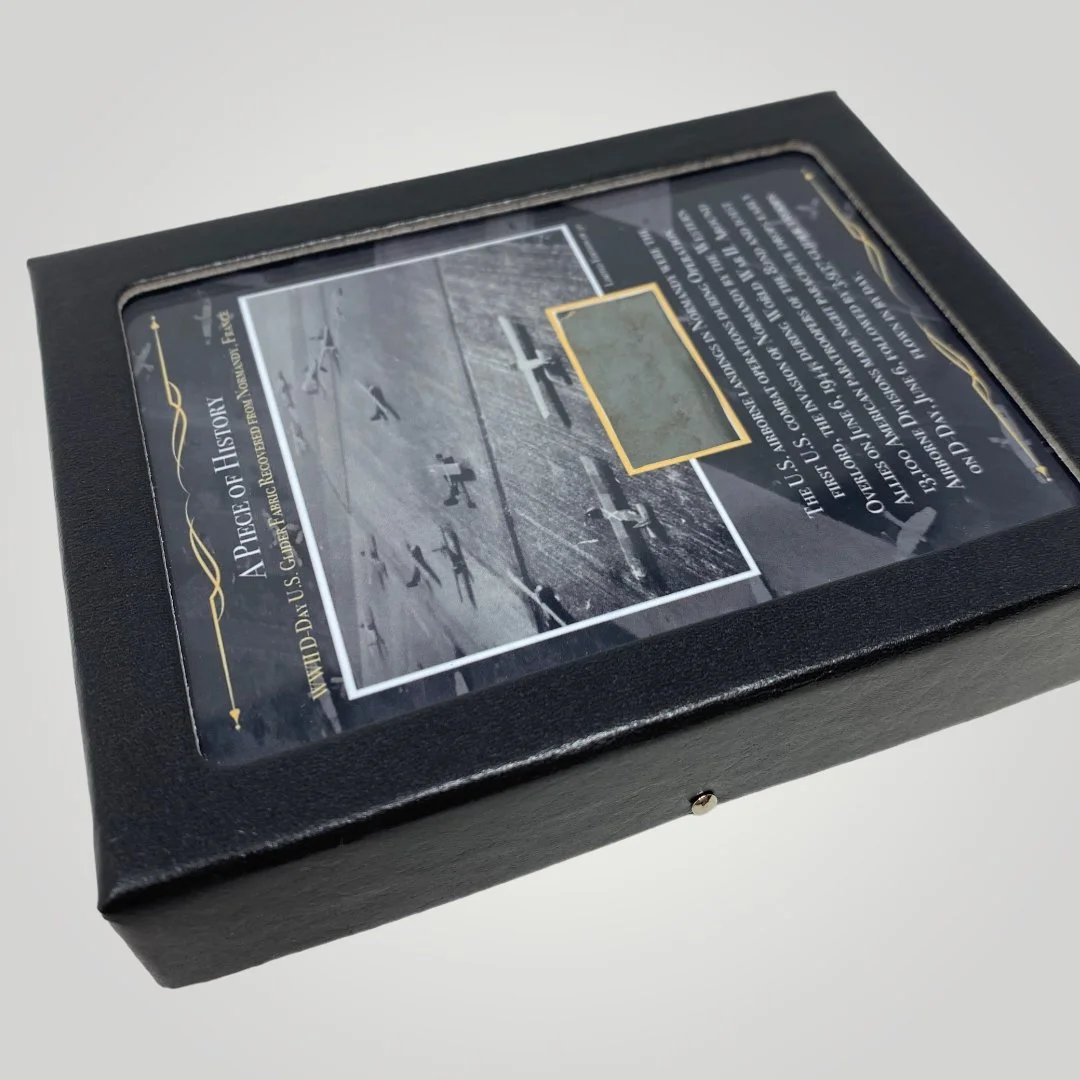RARE! WWII D-Day Normandy, France Recovered U.S. Glider Fabric with Display Case (C.O.A. Included)













RARE! WWII D-Day Normandy, France Recovered U.S. Glider Fabric with Display Case (C.O.A. Included)
Comes with a hand-signed C.O.A. and a full historical research write-up.
*Limited Edition of 50*
Own your piece of history today!
Due to an incredibly high demand for display case options we are proud to offer one of our LIMITED EDITION series of HISTORIC DISPLAY CASE EXCLUSIVES. This incredible “Piece of History“ is professionally encased in a glass display case with plush padding and a tightly sealed display case. Each displays features a historical photograph and short description that corresponds to the artifact displayed. This display case measures a perfect 4.25 inches tall x 3.25 inches wide.
This series is a limited edition of 50 pieces, meaning that each “Piece of History” display is unique. The glider artifact you receive may vary slightly from the display shown.
This incredibly rare and very historic piece of WWII history is an original U.S. glider fabric that was that was recovered from the D-Day Normandy drop zones designated for U.S. glider troops during Operation Overlord Allied D-Day landings on June 6th, 1944. The U.S. airborne landings in Normandy were the first U.S. combat operations during Operation Overlord, the invasion of Normandy by the Western Allies on June 6, 1944, during World War II. Around 13,100 American paratroopers of the 82nd and 101st Airborne Divisions made night parachute drops early on D-Day, June 6, followed by 3,937 glider troops flown in by day. Often dubbed “flying coffins” these D-Day gliders were made mostly from light wood and canvas fabric…thus, the gliders and their occupants were essentially defenseless against anti-aircraft flak. As they executed controlled crash landings, the gliders faced additional perils in the form of tree limbs, stone walls, or other ground hazards.
On June 6th, 1944, the world witnessed one of the most significant military operations in history, known as D-Day. As part of Operation Overlord, the Allied forces orchestrated an ambitious invasion of Normandy, France, to liberate Western Europe from the clutches of Nazi Germany. Central to this operation were the glider operations, which played a crucial role in delivering troops, equipment, and supplies to the battlefront. This essay will delve into the missions carried out by gliders on D-Day and shed light on the fabric and construction of these remarkable aircraft.
The Missions of D-Day Gliders: The glider operations on D-Day were diverse, encompassing a range of missions aimed at providing tactical advantage and logistical support to the invading forces. The primary objectives of the glider-borne troops included capturing key strategic locations, securing bridges, destroying enemy defenses, and establishing a secure supply chain.
Capture of Pegasus Bridge: One of the most iconic glider missions was the capture of Pegasus Bridge by British glider-borne troops. This operation involved landing gliders near the bridge over the Caen Canal, which was vital for the success of the invasion. The troops successfully overwhelmed the German defenders, securing the bridge and preventing any counterattacks.
Assault on Sainte-Mère-Église: American glider-borne troops played a critical role in the assault on Sainte-Mère-Église, a town of strategic importance. Gliders delivered soldiers from the 82nd and 101st Airborne Divisions, who landed amidst heavy fighting. Despite initial setbacks, their presence disrupted German reinforcements and allowed the Allies to gain control of the town.
Equipment and Supplies Delivery: In addition to carrying troops, gliders were used to transport vital equipment and supplies. Gliders towed by larger aircraft delivered heavy weapons, vehicles, and ammunition directly to the battlefront. This method proved crucial in ensuring that the troops had immediate access to necessary resources upon landing.
D-Day Glider Construction: To comprehend the challenges and successes of D-Day glider operations, understanding the fabric and construction of these aircraft is essential. Gliders were designed to be light, silent, and capable of making precise landings in hostile environments.
Wooden Frames: Glider frames were primarily constructed from lightweight wood, such as spruce, birch, and plywood. The wood was chosen for its availability and weight-saving properties, as it allowed the gliders to be towed more efficiently and quietly. The frames were meticulously engineered to provide structural integrity while minimizing weight.
Fabric Covering: The outer skin of the gliders was typically made from cotton or synthetic fabric, such as linen or rayon. This fabric covering was treated with various coatings to increase its durability and resistance to weather conditions. The fabric was stretched tightly over the wooden frames, ensuring aerodynamic efficiency.
Reinforcement: To enhance the strength of gliders and protect against damage during landing, additional reinforcements were applied to critical areas. Metal fittings, cables, and plywood were strategically placed to reinforce stress points and landing gear. These reinforcements aimed to withstand the impact of landing and prevent structural failures.
Minimalistic Design: Glider construction emphasized simplicity and minimized unnecessary components. Gliders lacked engines, reducing weight and mechanical complexity. The absence of engines also made them silent, enabling surprise landings and minimizing the risk of detection by enemy forces.
The glider operations during the D-Day invasion played a vital role in the success of Operation Overlord. These silent, lightweight aircraft undertook a variety of missions, including strategic captures, securing bridges, and delivering equipment and supplies. Glider fabric and construction, utilizing wooden frames and fabric coverings, prioritized lightweight, durable, and aerodynamically efficient designs. The bravery and skill of the glider-borne troops, combined with the ingenuity of these aircraft, contributed significantly to the Allies' triumph on D-Day and the subsequent liberation of Western Europe from Nazi occupation. The glider operations of D-Day remain a testament to the determination and resourcefulness of the Allied forces during World War II.